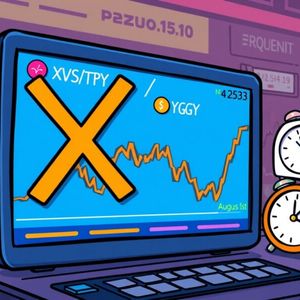Crucial Binance Delisting: What Traders Need to Know About XVS/TRY and YGG/TRY Pairs
10 min read
BitcoinWorld Crucial Binance Delisting: What Traders Need to Know About XVS/TRY and YGG/TRY Pairs The dynamic world of cryptocurrency trading is constantly evolving, with exchanges routinely making adjustments to their offerings to maintain a healthy and compliant ecosystem. A recent announcement that has caught the attention of many in the crypto community is the impending Binance delisting of specific spot trading pairs. For traders and investors holding XVS or YGG tokens, this update is not just news; it’s a call to action. Understanding the implications and preparing for these changes is crucial for managing your digital assets effectively. Understanding the Crucial Binance Delisting: What’s Happening? Leading global cryptocurrency exchange, Binance, recently made an important announcement via its official website. The exchange confirmed its decision to delist two specific spot trading pairs: XVS/TRY (Venus/Turkish Lira) and YGG/TRY (Yield Guild Games/Turkish Lira). This crucial Binance delisting is scheduled to take place on August 1st at 03:00 UTC . For those trading or holding these specific pairs, this means that after the stated time, you will no longer be able to execute spot trades involving XVS against TRY or YGG against TRY on the Binance platform. While delistings are a common occurrence in the fast-paced crypto market, each announcement carries specific implications for the affected assets and their holders. This particular Binance delisting highlights the exchange’s ongoing efforts to optimize its trading environment, ensuring liquidity and compliance across its vast array of offerings. It’s not uncommon for exchanges to periodically review their listed assets based on various criteria, and this move falls within that operational framework. Why Do Crypto Exchanges Like Binance Delist Trading Pairs? It might seem abrupt, but the decision to delist a trading pair is often a calculated move by exchanges like Binance. These decisions are not made lightly and are typically based on a rigorous review process designed to protect users and maintain a robust trading environment. Here are some of the primary reasons behind a Binance delisting or any exchange’s decision to remove a pair: Liquidity and Trading Volume: One of the most common reasons is low liquidity. If a trading pair doesn’t generate sufficient trading volume, it can lead to wider bid-ask spreads, increased slippage, and a less efficient market for traders. Exchanges aim to provide a vibrant marketplace, and illiquid pairs can detract from that experience. Project Performance and Viability: Exchanges continuously monitor the performance of listed projects. This includes assessing factors like development activity, community engagement, network stability, and overall project roadmap progress. If a project fails to meet certain performance benchmarks or shows signs of abandonment, it may be considered for delisting. Regulatory Compliance: The regulatory landscape for cryptocurrencies is constantly evolving. Exchanges must adhere to the laws and regulations of the jurisdictions they operate in. A token or trading pair might be delisted if it no longer meets specific regulatory requirements or if new regulations make its continued listing problematic. Security and Integrity Concerns: Any suspicion of market manipulation, security vulnerabilities, or unethical behavior associated with a token or its project can lead to a swift delisting. Exchanges prioritize the security of their users’ funds and the integrity of their trading platform. Community Feedback and User Protection: While less direct, user complaints or significant negative sentiment surrounding a project can also play a role. Exchanges aim to protect their users from projects that may be harmful or have malicious intent. In the case of the XVS/TRY and YGG/TRY Binance delisting , the exact specific reasons weren’t detailed in the public announcement, but they generally fall under one or more of these categories, reflecting Binance’s commitment to maintaining a high-quality trading ecosystem. What Does This Binance Delisting Mean for Your Portfolio? For individuals actively trading XVS/TRY or YGG/TRY, or simply holding XVS or YGG tokens on Binance, this announcement necessitates immediate attention. It’s not just about the removal of a trading option; it’s about understanding the next steps to manage your assets effectively. Here’s what you need to consider: Immediate Actions Required for Affected Users The most important takeaway is the deadline: August 1st, 03:00 UTC . Before this time, if you have open orders for XVS/TRY or YGG/TRY, Binance recommends that you cancel them. Any open spot orders for these pairs will be automatically canceled once the delisting takes effect. This is a standard procedure to prevent unexpected trades after the pair is removed. What about your XVS and YGG tokens? The delisting of a trading pair does not mean the underlying asset is removed from the exchange entirely, nor does it mean your tokens are gone. In this specific case, only the TRY pairs are being delisted. This means: You will still be able to trade XVS against other available pairs (e.g., XVS/USDT, XVS/BUSD if they are listed). You will still be able to trade YGG against other available pairs (e.g., YGG/USDT, YGG/BUSD if they are listed). You can still hold XVS and YGG tokens in your Binance wallet. You will still be able to withdraw XVS and YGG tokens from Binance to an external wallet or another exchange. However, the key implication is the removal of direct trading against the Turkish Lira for these specific assets. If your primary strategy involved trading these pairs against TRY, you will need to adjust your approach. Understanding Withdrawal Windows and Conversion Options While the XVS/TRY and YGG/TRY spot trading pairs are being removed, Binance typically provides a window for users to manage their assets. For instance, withdrawal services for the delisted tokens usually remain active for a period, allowing users to move their funds off the platform if they wish. Always check Binance’s official announcement for specific details regarding withdrawal timelines, as these can vary. If you hold XVS or YGG and want to convert them to fiat or other cryptocurrencies on Binance, you will need to use other available trading pairs. For example, you might convert XVS to USDT, and then convert USDT to TRY (if USDT/TRY is available) or withdraw USDT to a fiat on-ramp. This adds an extra step but ensures you can still manage your assets on the platform. Table: Actionable Steps for Affected Traders Scenario Recommended Action Before August 1st, 03:00 UTC Post-Delisting Options You have open XVS/TRY or YGG/TRY spot orders Cancel all open orders manually. Orders will be automatically canceled. You hold XVS or YGG tokens No immediate action required for holding. Trade against other available pairs (e.g., USDT), or withdraw to another wallet/exchange. You wish to trade XVS/YGG against TRY Execute trades before the deadline. Convert XVS/YGG to another stablecoin (e.g., USDT), then trade stablecoin for TRY, or withdraw. Navigating Future Binance Delistings: Proactive Strategies This recent Binance delisting serves as a valuable reminder for all crypto traders: the market is dynamic, and asset listings are not permanent. Developing proactive strategies can help you mitigate risks associated with such changes. Risk Management Strategies for Your Portfolio Diversification is key. Relying heavily on a single token or a small set of tokens, especially those with lower liquidity or smaller market caps, can expose you to higher risks during delistings or market volatility. Consider spreading your investments across a range of assets. Regularly review your portfolio. Stay informed about the projects you’ve invested in. Follow their development updates, community sentiment, and any news from the exchanges where they are listed. Early awareness of potential issues can give you time to react. Utilize stop-loss orders. While not directly related to delistings, using stop-loss orders can help manage risk by automatically closing a position if the price moves against you, preventing significant losses, especially in illiquid markets where delisting announcements can cause price drops. Staying Informed in a Fast-Paced Market Subscribing to official exchange announcements (like Binance’s), following reputable crypto news outlets, and participating in relevant community forums can help you stay ahead of such developments. Binance, like other major exchanges, typically provides ample notice before delisting, giving users time to adjust their positions. Broader Market Implications of a Binance Delisting While the delisting of two specific TRY pairs might seem minor in the grand scheme of Binance’s vast offerings, such events contribute to the broader narrative of market maturity and risk management within the crypto space. They underscore the importance of project resilience and the ongoing evaluation of digital assets by major platforms. Project Resilience and Investor Confidence When a major exchange like Binance delists a pair, it can impact the perception of the underlying project. For projects like Venus (XVS) and Yield Guild Games (YGG), the delisting of a specific fiat pair doesn’t necessarily signify the end of the project. However, it can affect their liquidity against that particular fiat currency and potentially influence investor confidence, especially if traders were heavily reliant on that specific pair. Conversely, projects that consistently meet listing requirements and maintain strong fundamentals demonstrate resilience, which can bolster investor confidence. This continuous evaluation by exchanges helps to filter out weaker projects, ideally leading to a healthier overall market. Market Sentiment and Evolution Each delisting, whether small or large, contributes to the overall market sentiment. It reminds participants that not all listed assets will succeed indefinitely and that due diligence is paramount. This process is a natural part of market evolution, as the crypto space matures and strives for greater stability and professionalism. It reinforces the idea that exchanges are actively curating their listings to provide a secure and efficient trading environment. Binance’s Commitment to a Healthy Ecosystem Binance’s decision to undertake this Binance delisting aligns with its stated commitment to fostering a robust and secure trading environment. The exchange frequently reviews all listed spot trading pairs to ensure a high standard of quality. Factors typically considered include: Commitment of team to project Level and quality of development activity Trading volume and liquidity Stability and security of network from attacks Network / smart contract stability Public communication from team Responsiveness to our periodic due diligence requests Evidence of unethical / fraudulent conduct or negligence Contribution to a healthy and sustainable crypto ecosystem By periodically removing pairs that no longer meet these stringent criteria, Binance aims to protect its users from potentially illiquid or problematic assets, ensuring that its platform remains a reliable choice for millions of traders worldwide. Actionable Insights for Crypto Enthusiasts Stay Informed: Regularly check official announcements from exchanges where you trade. Set up alerts for project updates. Understand the “Why”: Don’t just react to a delisting; try to understand the underlying reasons. This knowledge improves your market acumen. Diversify Wisely: Spread your investments across different assets and even different exchanges to minimize exposure to single-point risks. Have a Contingency Plan: Know your options for converting or withdrawing tokens if a pair you hold is delisted. Practice Risk Management: Only invest what you can afford to lose and consider tools like stop-loss orders. In conclusion, the upcoming Binance delisting of the XVS/TRY and YGG/TRY spot trading pairs on August 1st, 03:00 UTC, is a clear signal to affected traders to take prompt action. While delistings are a natural part of the evolving crypto landscape, they underscore the importance of vigilance, proactive portfolio management, and staying informed. By understanding the reasons behind such decisions and preparing accordingly, you can navigate these changes smoothly and continue to participate confidently in the dynamic world of cryptocurrency trading. Always refer to Binance’s official announcements for the most accurate and up-to-date information regarding your assets. Frequently Asked Questions (FAQs) Q1: What does “delisting a spot trading pair” mean? A1: Delisting a spot trading pair means that the cryptocurrency exchange (in this case, Binance) will no longer support direct trading between the two assets in that specific pair. For example, with XVS/TRY delisted, you can no longer directly exchange XVS for Turkish Lira (TRY) on Binance’s spot market. Q2: Will my XVS or YGG tokens disappear from my Binance account after the delisting? A2: No, your XVS and YGG tokens will not disappear. The delisting only affects the specific XVS/TRY and YGG/TRY trading pairs. You will still hold your XVS and YGG tokens in your Binance wallet, and you can still trade them against other available pairs (e.g., USDT) or withdraw them to an external wallet or another exchange. Q3: What should I do if I have open orders for XVS/TRY or YGG/TRY? A3: Binance recommends that you cancel any open spot orders for XVS/TRY or YGG/TRY before the delisting on August 1st at 03:00 UTC. Any remaining open orders for these pairs will be automatically canceled by the system once the delisting takes effect. Q4: Why does Binance delist certain trading pairs? A4: Binance delists trading pairs for various reasons, including low trading volume and liquidity, concerns about the underlying project’s performance or viability, regulatory compliance issues, security risks, or to ensure the overall quality and health of its trading ecosystem. These decisions are part of Binance’s regular review process. Q5: How can I stay informed about future Binance delistings or important announcements? A5: To stay informed, regularly check Binance’s official announcement page on its website. You can also follow their official social media channels, subscribe to their newsletters, and monitor reputable cryptocurrency news outlets that cover major exchange announcements. Q6: Does this delisting affect XVS or YGG on other exchanges? A6: This specific Binance delisting only affects trading on the Binance platform. The availability of XVS and YGG on other cryptocurrency exchanges is determined by those individual platforms and is not directly impacted by Binance’s decision. However, a major exchange delisting can sometimes influence broader market sentiment for the affected tokens. If you found this article insightful and helpful in navigating the recent Binance delisting , please consider sharing it with your network! Your support helps us continue to provide timely and crucial information to the crypto community. Share this article on Twitter, Facebook, LinkedIn, or your preferred social media platform to help others stay informed and make confident decisions in the fast-paced world of digital assets. To learn more about the latest crypto market trends, explore our article on key developments shaping Bitcoin’s price action. This post Crucial Binance Delisting: What Traders Need to Know About XVS/TRY and YGG/TRY Pairs first appeared on BitcoinWorld and is written by Editorial Team

Source: Bitcoin World



